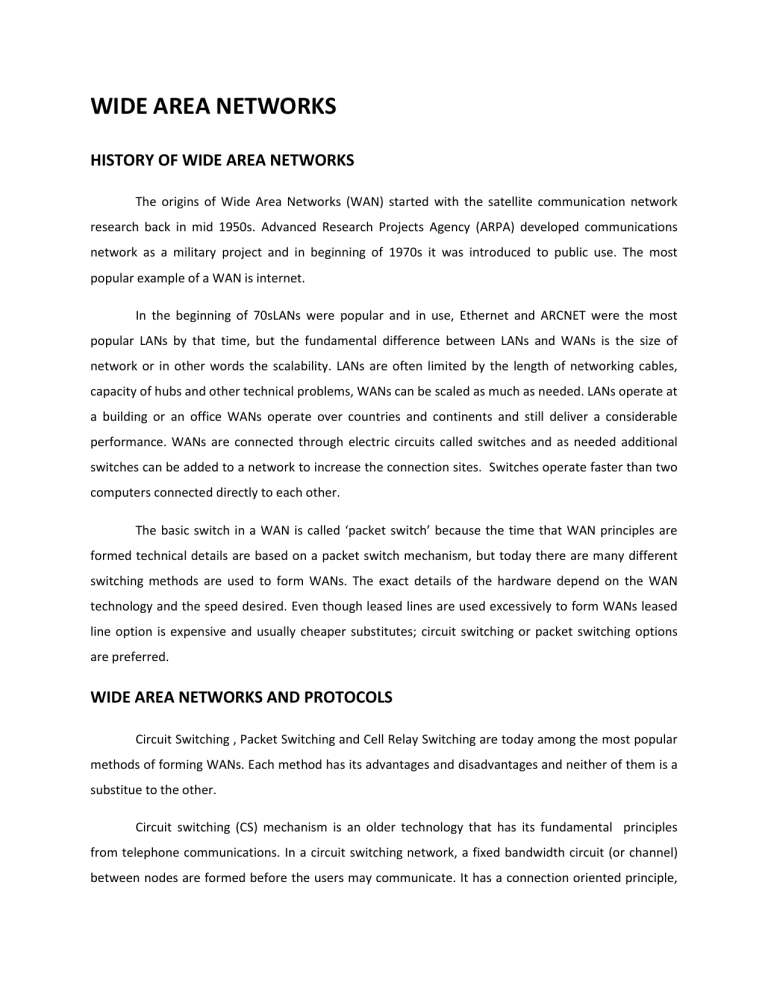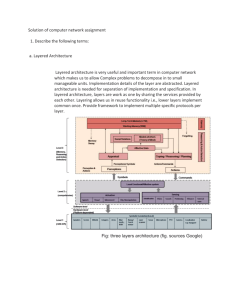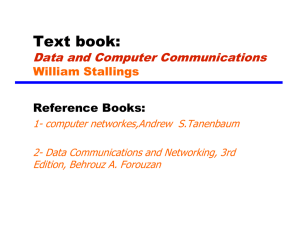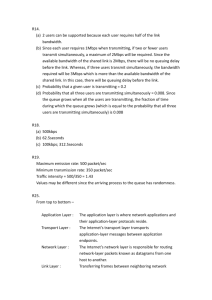WIDE AREA NETWORKS

WIDE AREA NETWORKS
HISTORY OF WIDE AREA NETWORKS
The origins of Wide Area Networks (WAN) started with the satellite communication network research back in mid 1950s. Advanced Research Projects Agency (ARPA) developed communications network as a military project and in beginning of 1970s it was introduced to public use. The most popular example of a WAN is internet.
In the beginning of 70sLANs were popular and in use, Ethernet and ARCNET were the most popular LANs by that time, but the fundamental difference between LANs and WANs is the size of network or in other words the scalability. LANs are often limited by the length of networking cables, capacity of hubs and other technical problems, WANs can be scaled as much as needed. LANs operate at a building or an office WANs operate over countries and continents and still deliver a considerable performance. WANs are connected through electric circuits called switches and as needed additional switches can be added to a network to increase the connection sites. Switches operate faster than two computers connected directly to each other.
The basic switch in a WAN is called ‘packet switch’ because the time that WAN principles are formed technical details are based on a packet switch mechanism, but today there are many different switching methods are used to form WANs. The exact details of the hardware depend on the WAN technology and the speed desired. Even though leased lines are used excessively to form WANs leased line option is expensive and usually cheaper substitutes; circuit switching or packet switching options are preferred.
WIDE AREA NETWORKS AND PROTOCOLS
Circuit Switching , Packet Switching and Cell Relay Switching are today among the most popular methods of forming WANs. Each method has its advantages and disadvantages and neither of them is a substitue to the other.
Circuit switching (CS) mechanism is an older technology that has its fundamental principles from telephone communications. In a circuit switching network, a fixed bandwidth circuit (or channel) between nodes are formed before the users may communicate. It has a connection oriented principle,
the connection is established and then the communication may start, and while a connection is established through two nodes, other nodes may not use the shared lines during the communication process. Circuit switches are actually designed for real-time audio communications and in time, with the necessity for carrying data over distances they are used in data transfer too. In circuit switching networks bandwidth allocation is not flexible and to overcome this limitation multiplexing techniques are implemented but with increased costs.
Public Switched Telephone Networking (PSTN) is a circuit switching network which is the conventional telephone networks as we know it. PSTN lines are pretty much digitalized today but they can still provide a maximum of 64Kpbs bandwidth. It is only used for dial-up connections from the scope of wide area networking. Integrated Services Digital Network (ISDN) is preferred over conventional dialup connection.
ISDN provides digitized voice and data to subscribers over conventional loop wiring over PSTN.
Two lines are used together forming a 128(2x64) Kbps bandwidth which is a slightly better choice over dial-up. ISDN service is usually provided in two different categories BRI and PRI. BRI is for individual users and PRI is for industrial or business solutions. A PRI connection can be formed of maximum of 30 lines which forms a 2 Mbit bandwidth in total. ISDN never became so popular because of the time it emerged cable connections and DSL connections become popular providing more bandwidth at a lower price.
Time Division Multiplexing (TDM) is a digital network in which two or more signals or bit streams are transferred apparently simultaneously. It is also formed on circuit switching principle but through one channel in a certain time data is streamed to many users. TDM is four line loop over PSTN which provides at least 256(4x64) Kpbs bandwidth and a considerable security because only a single line is used forming the network. However, multiplexing techniques increase the costs and in case of many terminals or computers share a single TDM line, the delay in turn for communications increase. TDM is a highly secure connection when a fixed bandwidth is not a limitation and a continuous data transfer is required between locations.
All the circuit switching networks share the same limitations, fixed bandwidth and delay in network communications. However considering that the entire world is connected through telephone lines they are used everywhere and easy to access.
Packet switching principles start with the design of ARPANET and they are formalised by the invention of X.25 networks. Packet switches can operate at a number of different levels in a protocol suite; although the exact technical details differ, fundamentally they all perform the same function: they store and forward packets. Packet switching is used to optimize the use of the channel capacity available in a network, to minimize the transmission latency.
X.25 networks were created in the era of dumb terminals before OSI model and designed to operate over analog telephone lines. Due to this assumption most of X.25 principles contains error recovery algorithms over analog phone lines. X.25 operates at a fixed bandwidth. X.25 never completely implemented itself into OSI model and with high the error recovery operations, it never became effective at using resources. X.25 is the earliest model of packet switching networking and it formed the basics for Frame Relay Networks.
Frame Relay connection is often used to connect two distant LANs through switches. It costs considerably less than leased lines and it offers flexible bandwidth and unlike X.25 it does not contain error recovery methods and it uses frames instead of packets. CIR in a Frame relay network is the average bandwidth for a virtual circuit guaranteed by an ISP to work under normal conditions. At any given time the bandwidth should not fall below this committed figure. Above the CIR, an allowance of burstable bandwidth is often given, known as the Excess Information Rate (EIR). The provider guarantees that the connection will always support the CIR rate, and sometimes the EIR rate should there be adequate bandwidth.
Frame Relay is a popular, cost and resource effective method for forming WANs. Eliminating its predecessor X.25’s error recovery waste, frame relays can operate at 20 times faster than X.25. Frame
Relay operates at OSI layer 1 and 2 but due to error corrections X.25 uses layers 1, 2 and 3. Using instead frames instead of packets, flexible bandwidth and effective use of resources made frame relay a popular choice.
Cell Relay Switch is a connection-oriented packet switched data communications protocol. Cell relay transmission rates usually are between 56 Kbit/s and several gigabits per second. ATM, a particularly popular form of cell relay, is most commonly used for home DSL connections. Cell Relay is a method of statistically multiplexing fixed-length packets, i.e. cells, to transport data between computers or kinds of network equipment. Cell relay is a newer technology compared to circuit and packet switches.
Asynchronous Transfer Mode (ATM) is a popular cell relay switching network and data link layer protocol which encodes data traffic into small (53 bytes; 48 bytes of data and 5 bytes of header information) fixed-sized cells. ATM is a connection-oriented technology, in which a logical connection is established between the two endpoints before the actual data exchange begins.
ATM is a channel-based transport layer, using Virtual circuits (VCs). This is encompassed in the concept of the Virtual Paths (VP) and Virtual Channels. Every ATM cell has a Virtual Path Identifier (VPI) and a Virtual Channel Identifier (VCI) pair defined in its header. These cells are used to establish the communication between two points and stored as headers in cells. Small and fixed size is the advantage of cells in ATM networks. No other header information is stored in cell other than VCs and the fixed size of a cell guarantees QoS (Quality of Service) and less memory fragmentation. Even though several gigabits of bandwidth for an ATM network is possible theoretically it does not happen. The basic flaw of
ATM is the assumption of homogeneity that the whole network is formed of cell relay switching. ATM does not integrate itself into other popular networking methods and it is quite complex. Implementing an ATM network and maintenance is quite costly compared other options even if it offers quite much bandwidth.
ROUTING IN WIDE AREA NETWORKS
The basic principle in a WAN switch is to store and forward packets. Directly from a computer or through a router a packet arrives at the switch. It is first stored at the switch, the processor examines the packet compares the destination address to it routing table and then it forwards the packet to other switch or computer. This technique allows a packet switch to buffer a short burst of packets that arrive simultaneously.
A switch contains the addresses of only other switches which are connected to it, and these addresses are stored in routing table. A packet switch does not keep complete information about how to reach all possible destinations. It only contains the addresses of the ones that are connected to it. A switch has information about the next place (hop) to send a packet. This procedure is called next-hop forwarding.
A packet switch must choose an outgoing path over which to forward each packet. If the packet is destined for one of the computers attached directly, switch forwards the packet to the computer. To make the choice, a packet switch uses the destination address stored in the packet compares it to the
routing table. Next-Hop forwarding occurs in the second phase of store and forward principle. Switches prefer the shortest path between switches to reach the destination path.









